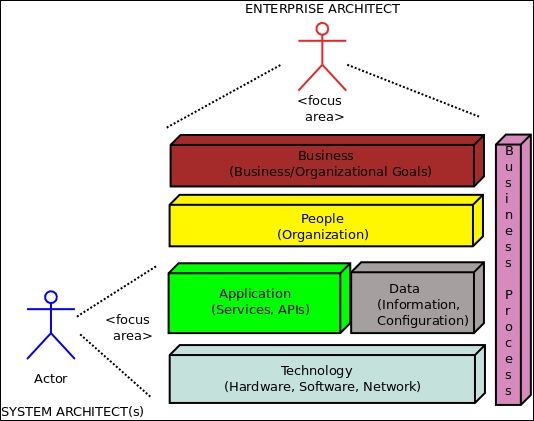You may have heard the term architect used in a few contexts. The following job roles or titles are pretty common in the software industry for architects:
- The Technical architect
- The Security architect
- The Information architect
- The Infrastructure architect
You also may have heard the term System architect, perhaps the term Enterprise architect, and maybe, Solution architect also. The interesting question is: What do these people do?
Let us try and find the answer to this question.
An Enterprise architect looks at the overall business and organizational strategies for an organization, and applies architecture principles and practices to guide the organization through the business, information, process, and technology changes necessary to execute their strategies. The Enterprise architect usually has a higher strategy focus and a lower technology focus. The other architect roles take care of their own subsystems and processes. For example:
- The Technical architect: The Technical architect is concerned with the core technology (hardware/software/network) used in an organization. A Security architect creates or tunes the security strategy used in applications to fit the organization's information security goals. An Information architect comes up with architectural solutions to make information available to/from applications in a way that facilitates the organization's business goals.
These specific architectural roles are all concerned with their own systems and subsystems. So, each of these roles is a System architect role.
These architects help the Enterprise architect to understand the smaller picture of each of the business domain they are responsible for, which helps the Enterprise architect to get information that will aid him in formulating business and organizational strategies.
- The System architect: A System architect usually has a higher technology focus and a lower strategy focus. It is a practice in some service-oriented software organizations to have a Solution architect, who combines the different systems to create a solution for a specific client. In such cases, the different architect roles are often combined into one, depending on the size of the organization, and the specific time and cost requirements of the project.
- The Solution architect: A Solution architect typically straddles the middle position when it comes to strategy versus technology focus and organizational versus project scope.
The following schematic diagram depicts the different layers in an organization–Technology, Application, Data, People, Process, and Business, and makes the focus area of the architect roles very clear:

Enterprise versus System architects
Let's discuss the preceding diagram a bit to understand the picture it lays out.
The System architect is pictured on the bottom-left side of the diagram, looking at the system components of the enterprise. His/her focus is on the applications that power the enterprise, their data, and the hardware and software stack powering the applications.
The Enterprise architect, on the other hand, is pictured on the top, having a top-down view of the enterprise including the business goals and the people, and not just the underlying systems that power the organization. The vertical stack of business processes connect the technical components that power the organization with its people and business components. These processes are defined by the Enterprise architect in discussion with the other stakeholders.
Now that you have understood the picture behind Enterprise and System architecture, let us take a look at some formal definitions:
"Enterprise Architecture is a conceptual blueprint that defines the structure and behavior of an organization. It determines how the organization's structure, processes, personnel and flow of information is aligned to its core goals to efficiently achieve its current and future objectives."
"A system architecture is the fundamental organization of a system, represented by its structural and behavioral views. The structure is determined by the components of the system and the behavior by the relationships between them and their interaction with external systems."
An Enterprise architect is concerned with how the different elements in an organization and their interplay is tuned towards achieving the goals of the organization in an efficient manner. In this work, he/she needs the support of not just the technical architects in the organization, but also people managing the organization, such as project managers and human resource professionals.
A Systems architect, on the other hand, is worried about how the core system architecture maps to the software and hardware architecture, and the various details of human interactions with the components in the system. His/her concern never arises above the boundaries defined by the system and its interactions.
The following diagram depicts the different focus areas and scopes of the different architect roles that we've discussed so far:

Scope and focus of various architect roles in a software organization
